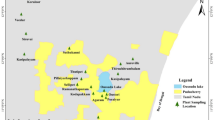Abstract
In this study, the levels of DDT and its metabolite residues were determined in chewable parts of Catha edulis plants grown in the southern part of Ethiopia. The levels of p,p′-DDT and p,p′-DDE were found to be in the range of 10.8–19.7 and 3.5–18.6 μg/kg, respectively. These data revealed that the residue being detected is from recent applications. The estimated daily intake of total DDT from C. edulis consumption was calculated to be in the range between 0.0278 and 0.0747 μg/kg, which is significantly lower than the FAO/WHO guideline. However, this may not guarantee safety, as the application of DDT extends to vegetables as well. Even though the use of DDT was banned in Ethiopia for agriculture purposes, detectable levels are still being observed. The results of the study necessitate the need for awareness creation among the people in the community.


Similar content being viewed by others
References
Arrafaine M (2004) Micro–macro-economic analysis of “Catha edulis” production in Ethiopia, MA thesis, Addis Ababa University, Addis Ababa, Ethiopia
Belew M, Kebede D, Kassaye M, Enquoselassie F (2000) The magnitude of Catha edulis use and its association with health, nutrition and socio-economic status. Ethiop Med J 38:11–26
Biego GHM, Yao KD, Ezoua P, Kouadio LP (2010) Assessment of organochlorine pesticides residues in fish sold in Abidjan markets and fishing sites. Afr J Food Agric Nutr Dev 10:2305–2323
Blasco C, Lino CM, Pico Y, Pena A, Font G, Silveira MIN (2004) Determination of organohlorine pesticide residues in honey from the central zone of Portugal and the Valencian community of Spain. J Chromatogr A 1049:155–160
Crentsil KB, Jacob A, Daniel AA, Juliana B, Stephen BA (2012) Contamination levels of selected organochlorine and organophosphorous pesticides in Ghanaian fruits and vegetables. Emir J Food Agric 24:293–301
Daba D, Hymete A, Bekhit AA, Mohamed AM, Bekhit Ael-D (2011) Multi residue analysis of pesticides in wheat and Catha edulis collected from different regions of Ethiopia. Bull Environ Contam Toxicol 86:336–341
Daneil K (2009) Assessment of pesticides use, practice and risk in Sidama farmers and residue analysis from selected sites. MSc thesis, Hawassa University, Hawassa, Ethiopia
Darko G, Acquaah OS (2007) Levels of organochlorine pesticides residues in meat. Int J Environ Sci Technol 4:521–524
El-Nahhal Y (2004) Contamination and safety status of plant food in Arab countries. J Appl Sci 4:411–417
European Commission Directorate General Health and Consumer Protection (2010) Guidance document on pesticide residue analytical methods. SANCO/825/00 rev. 8.1
FAO/WHO Food Standards Codex Almintarius (2013) Pesticide residues food and feeds. Geneva, Switzerland
Fouial-Djebbar D, Badjah-Hadj Ahmed YA, Budzinski H (2010) Determination of organochlorine compounds in coastal marine sediments from the southern west of the Mediterranean Sea. Int J Environ Sci Tech 7:271–280
Gebissa E (2010) Catha edulis in the horn of Africa: historical perspectives and current trends. J Ethnopharmacol. doi:10.1016/j.jep.2010.01.063
Guo J-Y, Zeng Ey F-C, Wu Meng X-Z, Mai B-X, Luo X-J (2007) Organochlorine pesticides in seafood products from southern china and health risk assessment. Environ Toxicol Chem 26:1109–1115
Hussen A, Megersa N, Westbom R, Retta N, Mathiasson L, Bjorklund E (2006) Optimization of pressurized liquid extraction for the determination of p,p′-DDT and p,p′-DDE in aged contaminated Ethiopian soil. Anal Bioanal Chem 386:1525–1533
Hussen A, Megersa N, Westbom N, Mathiasson L, Bjorklund E (2007) Selective pressurized liquid extraction for multi-residue analysis of organochlorine pesticides in soil. J Chromatogr A 1152:247–253
Imo ST, Sheikh MA, Hirosawa E, Oomori T, Tamaki F (2007) Contamination by organochlorine pesticides from rivers. Int J Environ Sci Tech 4:1–9
Joint FAO/WHO Food Standards Programme (2010) Draft and proposed draft maximum residue limits in foods and feeds, Xian, China, CX/PR 10/42/3
Linderholm L, Biague A, Mansson F, Norrgren H, Bergman A, Jakobsson K (2010) Human exposure to persistent organic pollutants in West Africa - A temporal trend study from Guinea-Bissau. Environ Int 36:675–682
Miller JN, Miller JC (2005) Statistics and chemometrics for analytical chemistry, 5th edn. Pearson Education Limited, Upper Saddle River
Muir D, Sverko E (2006) Analytical methods for PCBs and organochlorine pesticides in environmental monitoring and surveillance a critical appraisal. Anal Bioanal Chem 386:769–789
Odhiambo JO, Qi Shihua, Xing X, Zhang Y, Muhayimana Annette S (2009) Residues of organochlorine pesticides in vegetables from Deyang and Yanting areas of the Chengdu economic region, Sichuan Province, China. J Am Sci 5:91–100
Rodrigues MVN, Felix GRR, Pedro MM, Susanne R (2007) GC-MS determination of organochlorine pesticides in medicinal plants harvested in Brazil. J Brazil Chem Soc 18:135–142
Ssebugere P, Wasswa J, Mbabazi J, Nyanzi SA, Kiremire BT, Marco JA (2010) Organochlorine pesticides in soils from south-western Uganda. Chemosphere 78:1250–1255
Tomza-Marciniak A, Witczak A (2010) Distribution of endocrine-disrupting pesticides in water and fish from the Oder River Poland. Acta Ichthyol Piscatoria 40:1–9
WHO (2007) Guidelines for assessing quality of herbal medicines with reference to contaminants and residues, Geneva, Switzerland. ISBN:978 92 4
Zhu Y, Liu H, Xi Z, Cheng H, Xu X (2005) Organochlorine pesticides (DDTs and HCHs) in soils from the outskirts of Beijing, China. Chemosphere 60:770–778
Acknowledgments
The authors gratefully acknowledge financial support received from the Norwegian Programme for Development, Research and Education (NUFU) project, at Dilla university. Officials at the Agricultural Product Quality Monitoring and Testing Laboratory, Fededral Ministry of Agriculture, Ethiopia are highly appreciated for providing use of their GC-ECD instrument for this research work. We thank V. M. Rao, B. S. Reddy and M. K. Choudhury for editing the manuscript.
Author information
Authors and Affiliations
Corresponding author
Rights and permissions
About this article
Cite this article
Ligani, S., Hussen, A. Determination of Organochlorine Pesticide Residue Levels in Chewable Parts of the Khat (Catha edulis) Plant. Bull Environ Contam Toxicol 93, 591–595 (2014). https://doi.org/10.1007/s00128-014-1385-4
Received:
Accepted:
Published:
Issue Date:
DOI: https://doi.org/10.1007/s00128-014-1385-4




